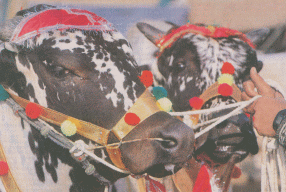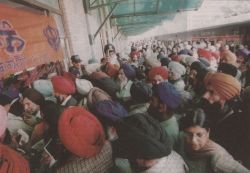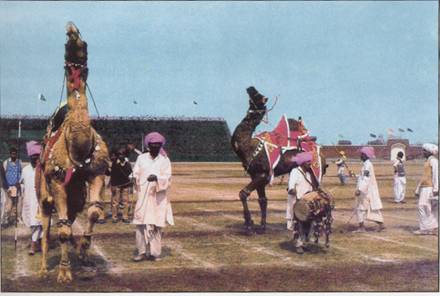

Festivals and fairs inject life and vigour in the lives of the people living anywhere in the world. Be it tomato throwing or racing in front of fuming bull, despite the danger the show goes on with lots of fun and laughter. Likewise, people in Pakistan have their own way of sharing love and joy.

Eid ul Fitr and Eid ul Azha are the two major religious festivities celebrated throughout the country among its Muslim populace.
Thankfulness is one of the four qualities of a Muslim, others being truthfulness, modesty and good behaviour. Eid ul Fitr is the day of rejoicing and thanksgiving to Allah for giving the strength to the believers to fast for 29-30 days during the holy month of Ramadan. The day is celebrated at the end of the Ramadan on the first of Shawal (the 10th month of Islamic calendar). In the evening of 29th Ramadan, all men and women alike flock on the rooftops to witness the new moon. No sooner it is sited, a euphoria sets in and everyone rushes to market places to make the last day shopping. Girls flock the stalls to get their hands beautiful decorated with "henna". On Eid day, women folk prepare delicious sweet dishes to celebrate the beginning of the day. Before going for the exclusive morning prayers, each head of the family is to give "fitrana" (alms) equal to 2 1/2 kilo of wheat in respect of each member of his family to the poor and needy so that they could also share the joy and happiness of the day. After the prayers children gather around the head of the family to receive "Eidi" - a sum of money as per the status and financial position of the head - a ritual in which everyone shares. A lot of fairs are organized for children while the elders call on to the relatives. More than men, women and children (specially girls) enjoy the festivities of the day by wearing colourful specially made-for-the-occasion clothes.



Eid ul Azha is celebrated on 10th day of the Zil Hajj (the 12th Islamic month). This day is celebrated in the memory of the sacrifice made by the prophet Abraham (Abraham) wherein he offered the life of his son Prophet Ismail to fulfill the decree of the Allah. On this day, all people who can afford sacrifice a sheep or a goat in the name of Allah as was done by prophet Abraham. Here too the poor are not forgotten. The meat of the sacrificed goat/sheep/lamb is divided into three parts; one for distribution among the poor, second for the relatives and third for self and own family.
In addition to the two Eids, the 12th of Rabi-al-Awwal (3rd month of Islamic calendar) is celebrated as the birthday of the prophet Muhammad (may peace be upon Him) with religious zeal and fervour. The roads, shops and other buildings are skillfully decorated with buntings and lights to express love and devotion to the Prophet Muhammad (may peace be upon Him). Special conferences are held to project the peacefulness of the religion of Islam and the way the prophet Muhammad (peace be upon him) desired it to be followed. How sad it is that a faction of Muslim hardliners have given a new and ugly dimension to this peaceful religion by terrorizing the world. This certainly isn't the Islam Allah and His Prophet wanted. Islam continues to be a religion of peaceful co-existence despite what some radicals are trying to portray it otherwise.
The Christian community celebrates Christmas, Easter and other religious festivals as are celebrated all over the world.
Although the Christmas day coincides with the birthday celebrations of the father of the nation, Muhammad Ali Jinnah, on 25th December, Muslims also visit homes of Christian friends to celebrate Christmas with them. The other minorities like Hindus, Sikhs and Parsis also celebrate their
religious days with equal enthusiasm. In fact the largest community that comes from all over the world to Pakistan are the Sikhs who flock their
religious sites in thousands, specially the Baba Guru Nanak birthday celebrations, in November each year.
Non Muslim Religious Festivals


Spring always brings happiness and adds hues to life as flowers blossom and birds sing and chirp happily. Lahore, the city of gardens covers itself with multicolour flowers and it is then that the festivities of Spring Festival, locally known as the "Jashan-e-Baharan" get into their full swing. Likewise all over the country, the spring is welcomed with dance of men and trained animals and music. Some of the festivals worth mentioning are:
Basant in Lahore (Courtesy Abbrar)
|
|
|
| HOME PAGE | MORE ABOUT CULTURE | Copyright©JalalsPages - 2005 - 2009 |